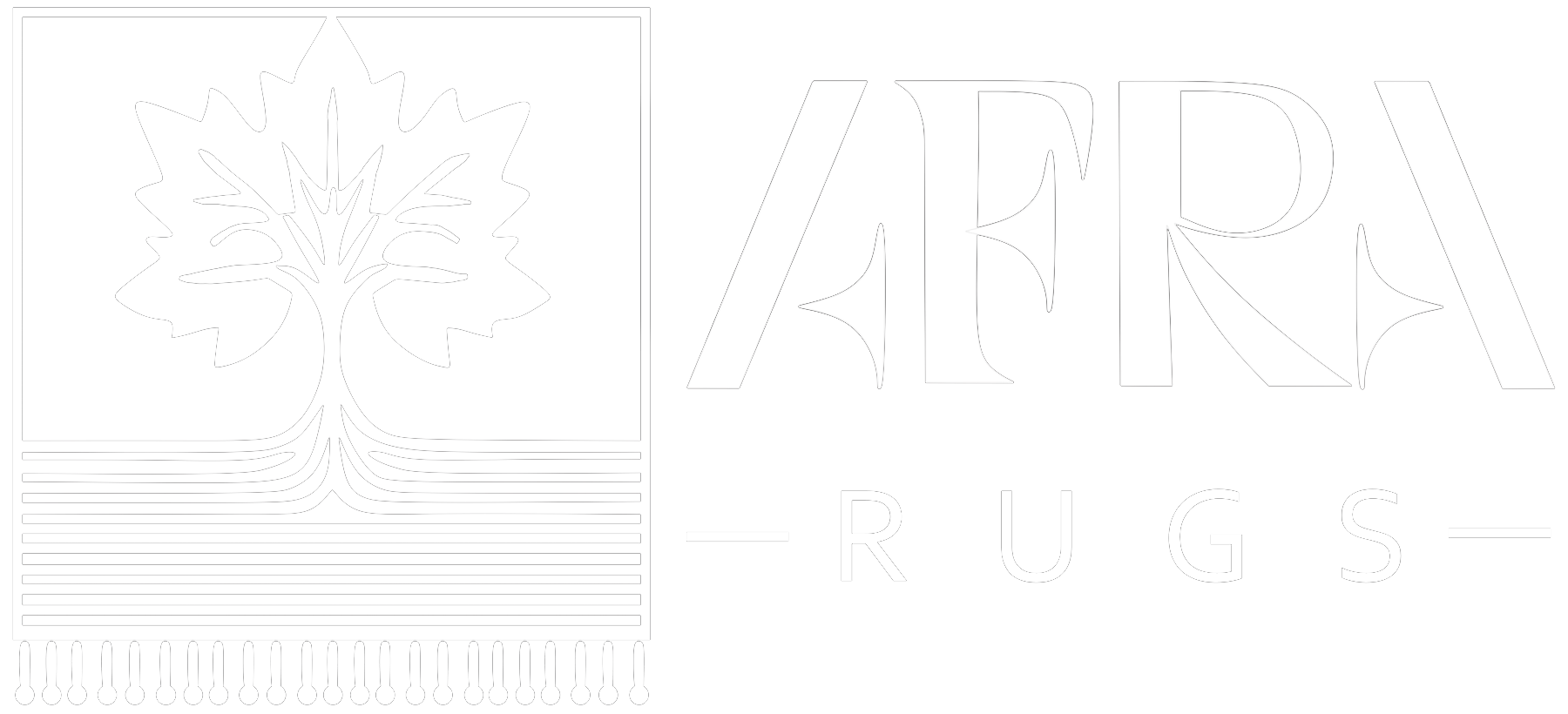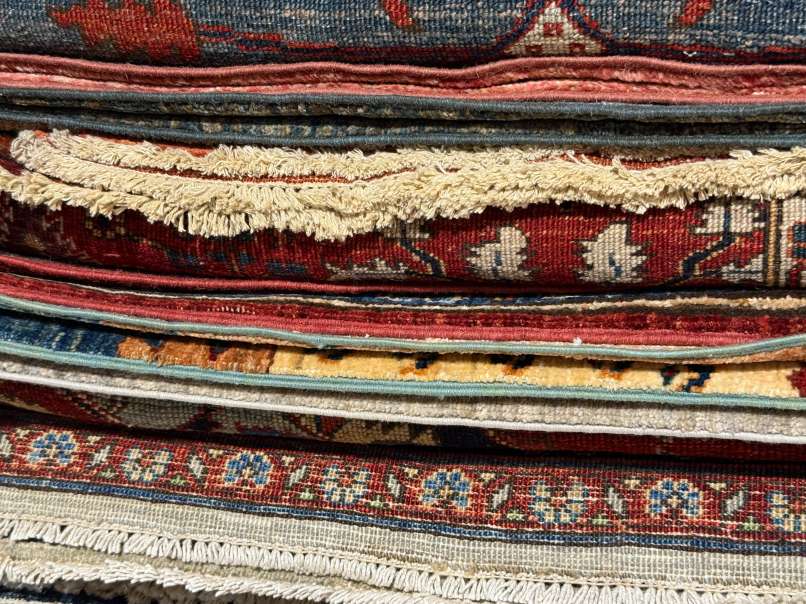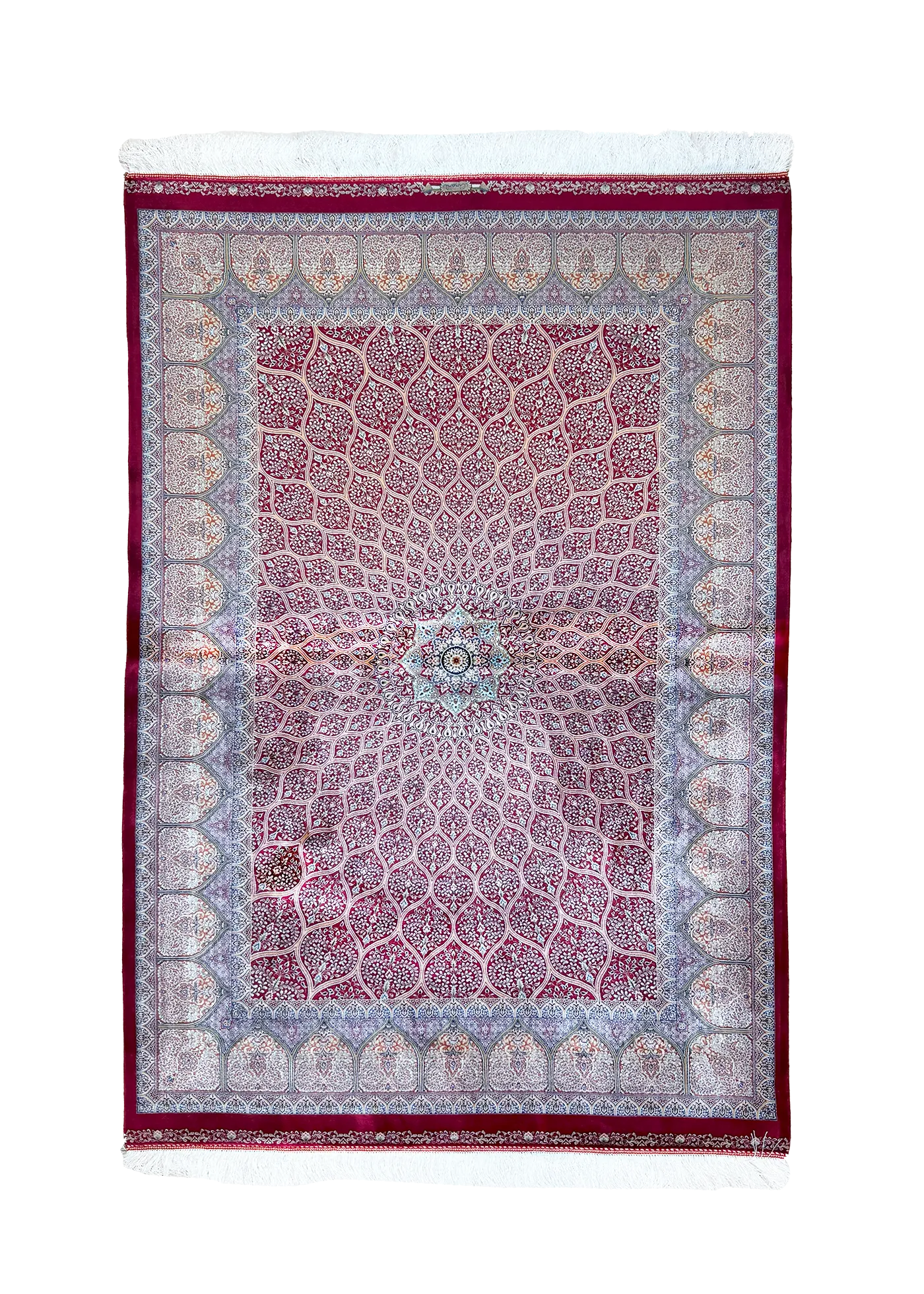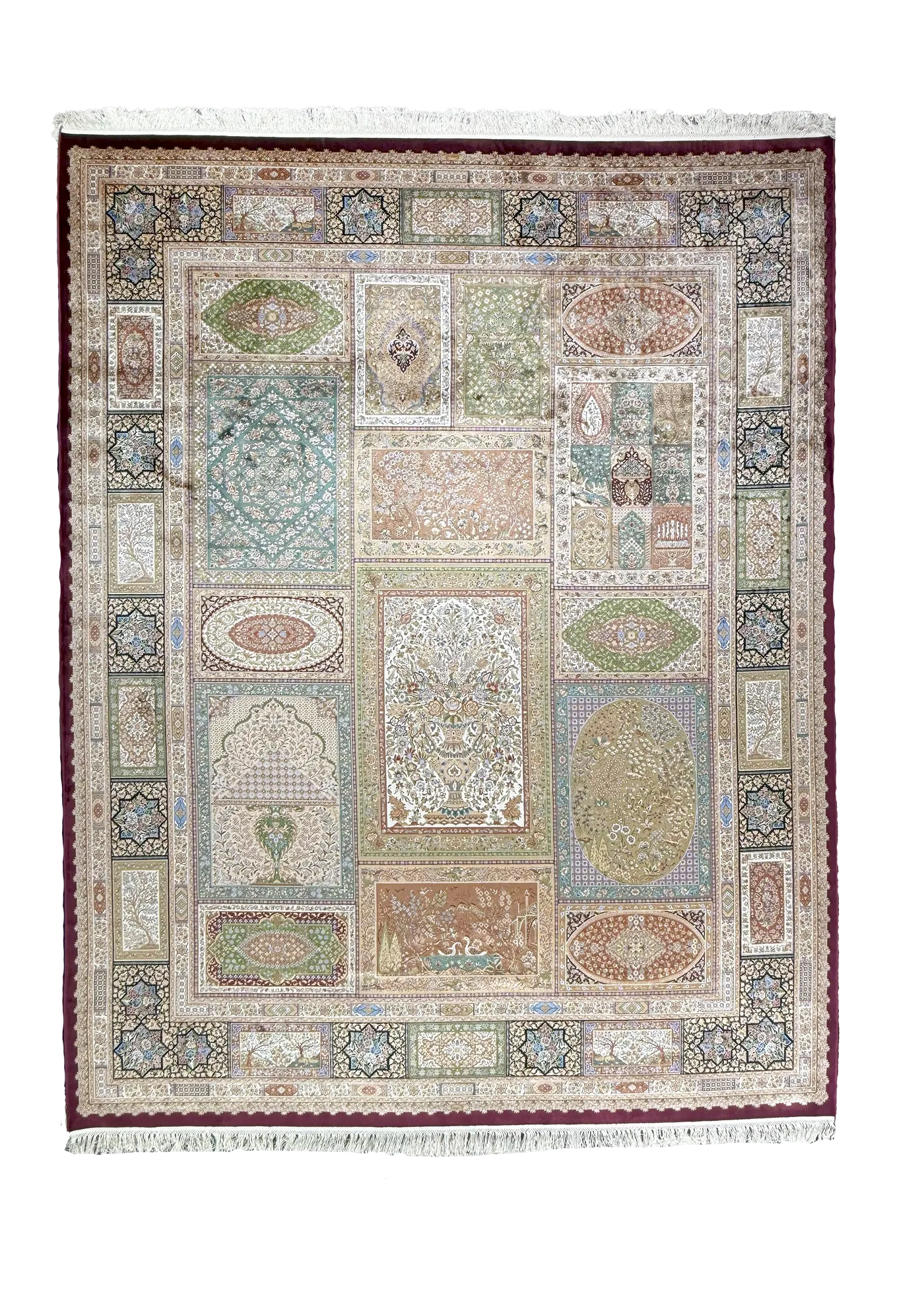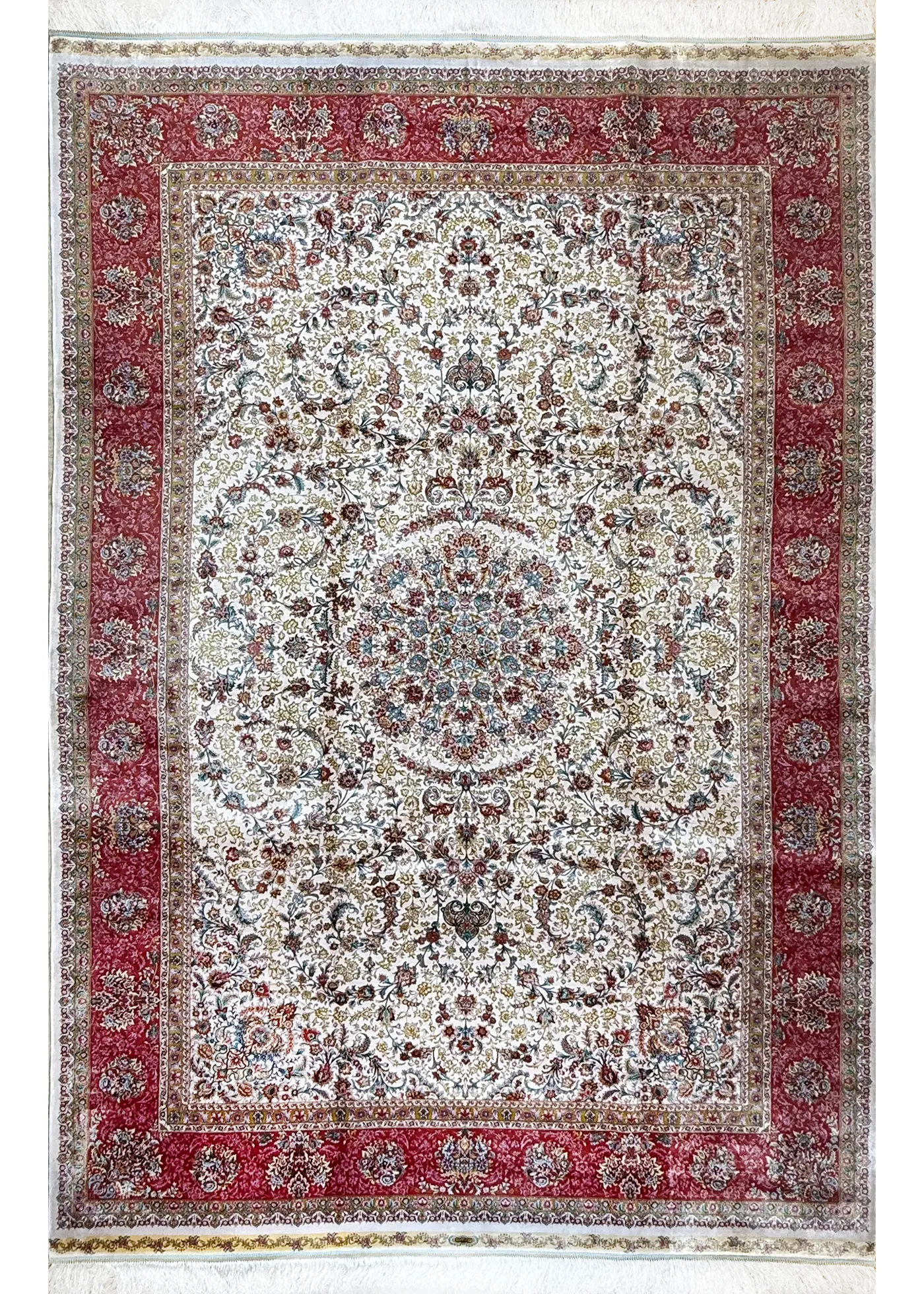Unveiling the Elegance of a Qum Silk Carpet
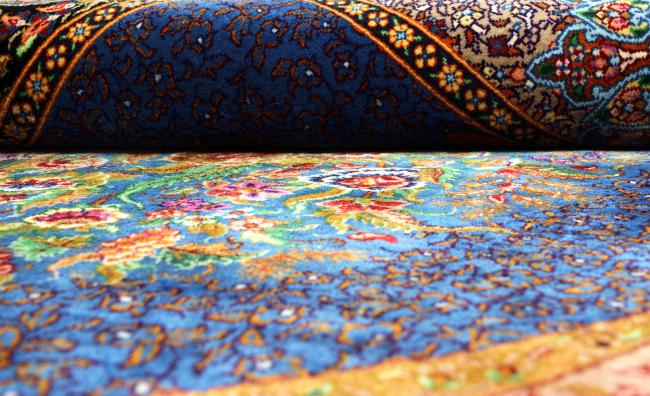
- 1 Red and Blue Persian Rug Vanda Pattern 5 x 8
- 2 Introduction: Unveiling the Elegance of a Qum Silk Carpet
- 3 Section 2: Artistry and Craftsmanship of Silk Persian Rugs
- 4 Section 3: Cultural Significance of Qum Silk Carpets
- 5 Section 4: Why Qum Silk Carpets Endure Today
- 6 Infographic: Timeline of Qum Silk Persian Rug History
- 7 Conclusion: Unveiling the Elegance of a Qum Silk Carpet
Introduction: Unveiling the Elegance of a Qum Silk Carpet
Imagine stepping into a room where a silk Persian rug shimmers under soft light, its intricate patterns telling a story of centuries-old artistry. Qum silk carpets, hailing from the Persian city of Qum, captivate with their delicate designs and vibrant colors. These rugs weave together history, culture, and craftsmanship, creating pieces that feel like treasures from another era. In this article, we dive into the world of Qum silk Persian rugs, exploring their origins, artistry, and enduring appeal. Whether you’re a rug enthusiast or simply curious, you’ll discover why these carpets hold a special place in homes worldwide. Join us to uncover the magic of Qum carpets and find inspiration in our Traditional Persian Rugs Collection at Afra Rugs, where timeless designs meet modern elegance.
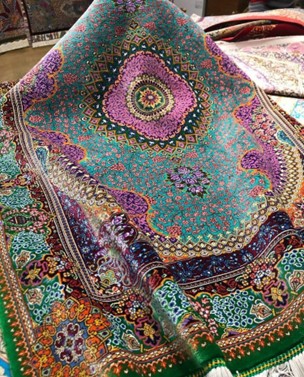
The intricate details and mesmerizing patterns on this rug are simply stunning. Every square inch tells a story of craftsmanship.
Section 1: The Origins of Qum Silk Carpets
Qum, a city in central Persia, emerged as a rug-making hub in the early 20th century, relatively late compared to older weaving centers like Tabriz or Kashan. Unlike traditional rug-making regions, Qum’s carpet industry blossomed in the 1930s, driven by skilled weavers who embraced silk to create finer, more detailed designs. A silk Persian rug from Qum stands out for its precision, often featuring a higher knot count than wool counterparts, allowing for intricate patterns that rival miniature paintings.
The city’s weavers drew inspiration from Persia’s rich artistic heritage, blending local motifs with influences from other regions. Qum carpets quickly gained fame for their quality and beauty, becoming sought-after pieces globally. By focusing on silk, weavers crafted rugs that shimmered with a unique luster, elevating Persian rug styles to new heights. This historical context sets Qum apart as a center of innovation in rug-making, where tradition meets refinement.
The Rise of Qum’s Rug Industry
Qum’s rug-making began as a response to growing demand for luxury textiles. Weavers in the city experimented with silk, a material that allowed for tighter knots and more detailed designs. By the mid-20th century, Qum silk Persian rugs became synonymous with elegance, often adorning palaces and homes of the elite. The city’s strategic location along trade routes helped spread its rugs’ fame, connecting Qum’s artistry to a global audience. This rise cemented Qum’s place in the world of Persian rug styles, making its carpets a symbol of sophistication.
Key Historical Milestones
Qum’s carpets evolved rapidly. In the 1930s, weavers introduced silk pile and warp, creating rugs with unparalleled finesse. By the 1950s, Qum silk Persian rugs featured diverse designs, from floral motifs to pictorial scenes, reflecting Persia’s cultural depth. These milestones highlight why Qum carpets remain a pinnacle of rug artistry, inspiring modern collections like Afra Rugs’ Traditional Persian Rugs Collection.
Section 2: Artistry and Craftsmanship of Silk Persian Rugs
A Qum silk Persian rug dazzles with its intricate designs, often resembling a canvas of art. Weavers use fine silk threads to create patterns so detailed they seem to dance under light. Common Persian rug styles in Qum include medallion centers, floral borders, and pictorial scenes depicting gardens or historical events. These designs require precision, with knot counts often exceeding 500 per square inch, showcasing the weaver’s skill.
Table: Common Qum Silk Persian Rug Patterns
| Pattern Type | Description | Notable Features |
| Floral | Intricate flowers and vines | Vibrant colors, delicate curves |
| Medallion | Central star or diamond motif | Symmetrical, bold focal point |
| Pictorial | Scenes of gardens or history | Storytelling, artistic detail |
| All-Over | Repeating geometric shapes | Uniform, intricate coverage |
Caption: This table highlights the diversity of Qum silk Persian rug patterns, showcasing their artistic range.
The use of silk enhances color vibrancy, from deep reds to soft ivories, making each rug a visual masterpiece. Weavers often incorporate gold or silver threads, adding a luxurious sheen. These qualities make Qum silk Persian rugs a favorite for those seeking elegance, reflected in Afra Rugs’ Traditional Persian Rugs Collection, where bamboo silk captures similar sophistication.
Techniques Behind the Art
Creating a Qum silk Persian rug involves meticulous techniques. Weavers use the Persian knot, allowing for tight, precise patterns. Silk’s strength enables finer weaves, resulting in crisp, detailed designs. Dyes, often derived from natural sources like saffron or indigo, produce rich hues that endure over time. These techniques highlight the artistry behind Persian rug styles, ensuring each Qum carpet feels like a work of art.
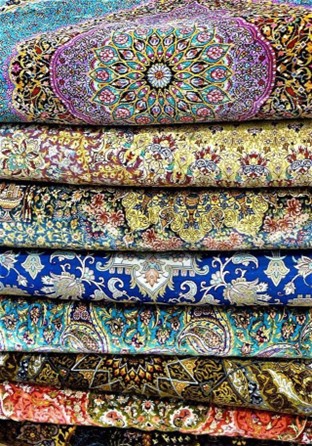
A close-up shot of a colorful stack of Persian-style rugs, showcasing a variety of intricate patterns and rich colors, including blue, yellow, and purple.
Modern Inspirations
Today, Qum’s influence inspires contemporary: modern silk Persian rugs, like those in Afra Rugs’ Traditional Persian Rugs Collection, which use bamboo silk to mimic the sheen and intricacy of Qum designs without claiming traditional materials. This blend of heritage and innovation keeps Qum’s legacy alive.
Section 3: Cultural Significance of Qum Silk Carpets
Qum silk Persian rugs carry deep cultural meaning, reflecting Persia’s artistic and spiritual heritage. Each motif tells a story, weaving together symbols of life, faith, and nature. For example, the boteh (paisley) motif symbolizes fertility, while floral designs evoke paradise gardens, a nod to Persian poetry and spirituality.
List: Symbolic Motifs in Qum Silk Persian Rugs
- Boteh: Represents fertility and eternal life, shaped like a teardrop or pinecone.
- Floral Patterns: Symbolize paradise gardens, reflecting beauty and divinity.
- Bird Motifs: Depict freedom and spiritual connection, often in pairs.
- Tree of Life: Signifies eternity and growth, a common central design.
- Geometric Borders: Represent harmony and order, framing intricate designs.
These motifs elevate Qum silk Persian rugs beyond decor, making them cultural artifacts. They embody Persia’s storytelling tradition, where every knot carries meaning. This cultural richness inspires Afra Rugs’ Traditional Persian Rugs Collection, which celebrates classic Persian rug styles with modern flair.
A Universal Appeal
Qum carpets transcend cultural boundaries, appealing to anyone who values artistry. Their intricate designs and vibrant colors speak to universal themes of beauty and heritage. A Qum silk Persian rug in a modern home feel like a bridge to history, connecting past and present through Persian rug styles that resonate globally.
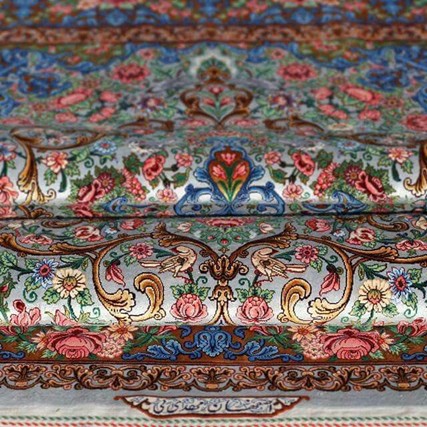
Layers of elegance. The beautiful colors and soft sheen of this rug speak to its luxurious craftsmanship.
Section 4: Why Qum Silk Carpets Endure Today
Qum silk Persian rugs remain timeless due to their unmatched beauty and craftsmanship. Their fine silk construction creates a luminous quality that captivates in any setting. The intricate designs, from medallions to pictorial scenes, offer versatility, complementing both classic and contemporary spaces. Their rarity—due to the labor-intensive process—adds to their allure, making them cherished pieces.
Modern technology, like bamboo silk used in Afra Rugs’ Traditional Persian Rugs Collection, brings Qum-inspired elegance to today’s homes. These rugs maintain the spirit of Persian rug styles while offering durability and accessibility. Their ability to blend tradition with modern needs ensures Qum carpets remain relevant, inviting appreciation from all who encounter them.
A Legacy of Artistry
The legacy of Qum silk Persian rugs lies in their ability to tell stories through design. Each rug captures a moment in Persian history, from ancient gardens to modern artistry. This enduring quality makes them more than decor—they’re heirlooms that inspire awe, much like the offerings in Afra Rugs’ Traditional Persian Rugs Collection.
Infographic: Timeline of Qum Silk Persian Rug History

Description: This infographic traces the history of Qum silk Persian rugs, starting with their rise in the 1930s, marked by the use of fine silk for intricate designs. The 1950s saw diverse Persian rug styles like pictorial scenes emerge. By the late 20th century, Qum rugs gained global fame for their artistry. Today, their legacy inspires modern collections like Afra Rugs’ Traditional Persian Rugs Collection. Credit: Infographic by Afra Rugs.
Conclusion: Unveiling the Elegance of a Qum Silk Carpet
Qum silk Persian rugs weave a tapestry of history, artistry, and culture, captivating with their intricate designs and luminous silk. From their 20th-century origins to their modern-day appeal, these rugs embody timeless elegance, with motifs that tell stories of Persian heritage. Their versatility and beauty make them cherished additions to any home. Dive into the world of classic Persian rug styles and explore Afra Rugs’ Traditional Persian Rugs Collection to find a piece that brings Qum’s legacy to life.
FAQ
- What makes a Qum silk Persian rug unique?
A Qum silk Persian rug stands out for its fine silk threads, high knot counts, and intricate designs like floral or pictorial motifs, embodying elegant Persian rug styles.
- How can I identify a Qum silk Persian rug?
Look for vibrant colors, detailed patterns (e.g., medallions, boteh), and a luminous sheen, hallmarks of Qum’s silk Persian rug craftsmanship.
- Are Qum silk Persian rugs suitable for modern homes?
Yes, their timeless Persian rug styles complement both classic and contemporary decor, as seen in Afra Rugs’ Traditional Persian Rugs Collection.
- What are common Qum silk Persian rug designs?
Floral, medallion, pictorial, and all-over patterns define Qum silk Persian rugs, each rich with cultural symbolism.
- How do Qum rugs differ from other Persian rug styles?
Qum rugs use finer silk and higher knot counts, creating more intricate, luminous designs compared to other Persian rug styles.
